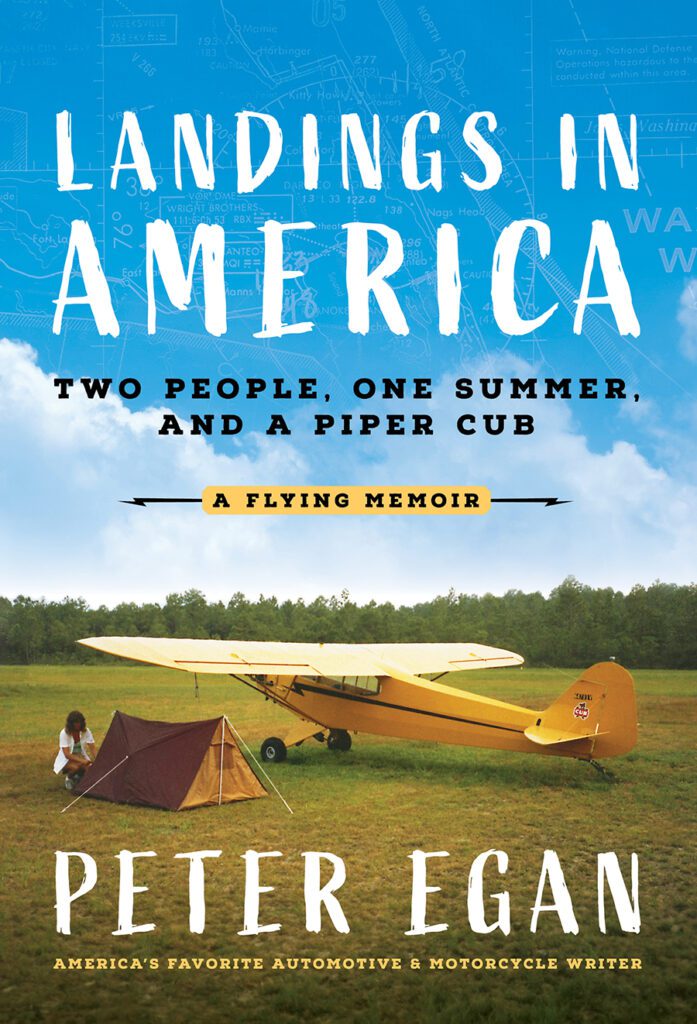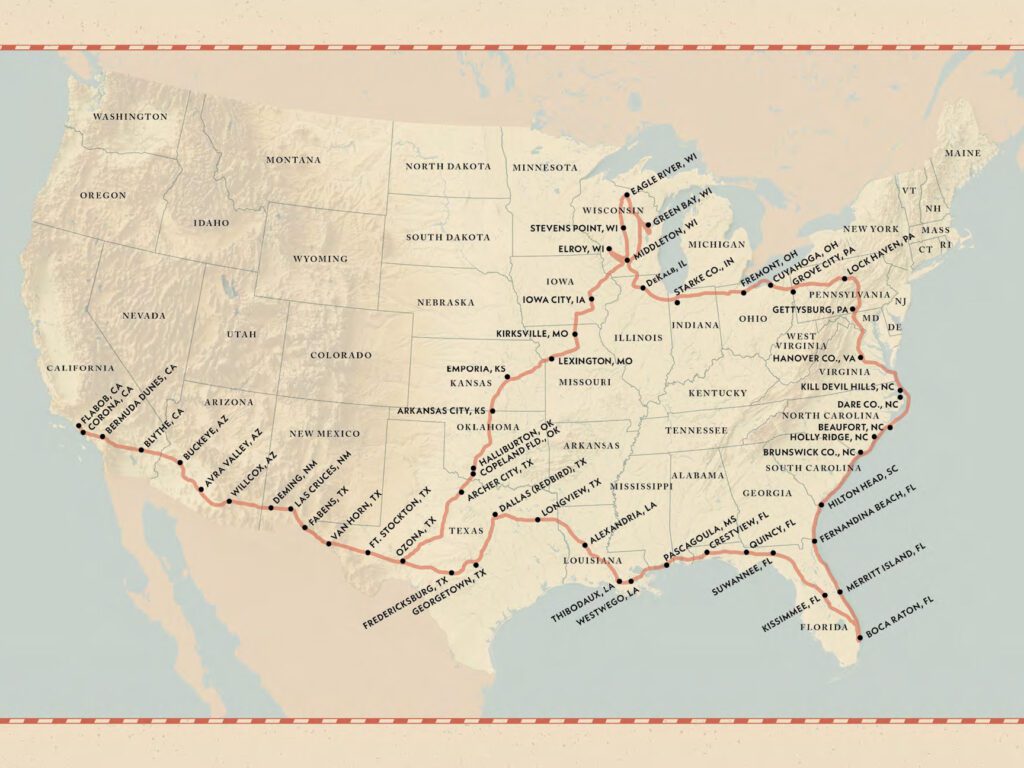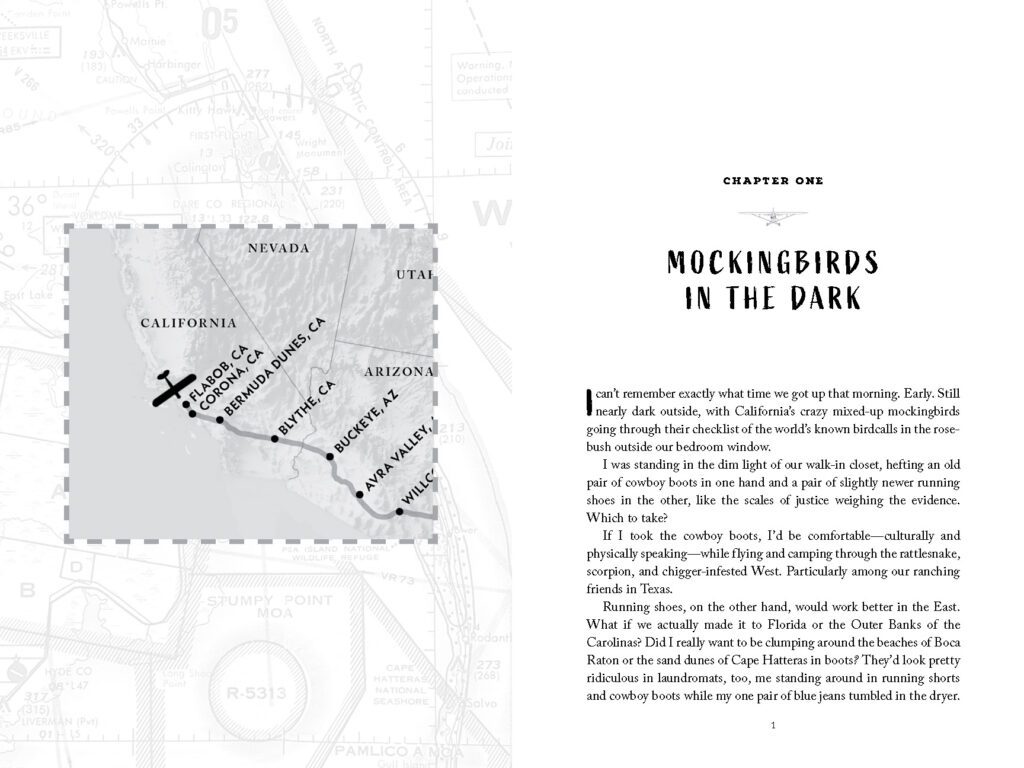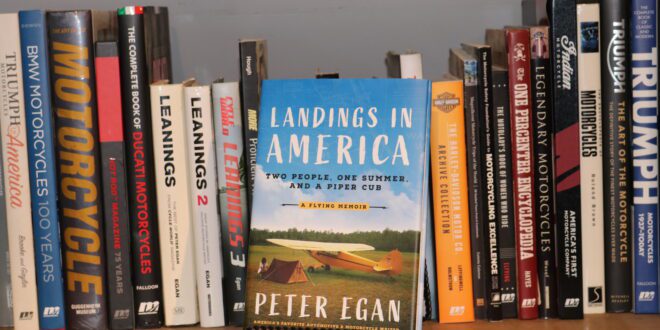HARWINTON, CT – Peter Egan is revered among car and motorcycle enthusiasts for his many contributions to “Road & Track” and “Cycle World” magazines over the decades; mainly the “Side Glances” and “Leanings” columns that were later collected into book form.
His columns mixed romance with nuance, precise details with scope, and captured models, events and experiences in a manner that was informative, insightful and entertaining. They made the reader recall similar happenings in their own life; that is, when not nodding in agreement, stopping to digest or research an unknown reference or word, or simply laughing.
If you’re an Egan fan, get ready to be reminded of his keyboard dexterity. This time, though, he escapes the pavement and literally takes flight. Along with his wife, Barb.

I’ve just spent two days reading his newest book – the soon-to-be released “Landings in America” – and can advise that it’s not only for his longtime followers. It’s also a treat for pilots, gas jockeys at small airport fuel pumps, small-town café hash slingers, and anyone else who enjoys extraordinary writing skills or yearns for adventure from the comfort of an easy chair.
“Landings in America” is vintage Egan. The book’s described on the cover as “A Flying Memoir” that involves “Two People. One Summer. And A Piper Cub.” It also deals with meteorology, topography, faulty equipment, historical happenings, brief scares and interesting folks – both friends and strangers – met along a 7,000-mile route.
Egan literally went above and beyond the nation’s Interstate highways, city streets and dusty rural roads, following roads, railroad tracks and rivers, to get from California to the East Coast and back. The book recalls the six-week journey that he took with his wife in the summer of 1987. Often “microwaved by wind, heat and vibration,” they barnstormed at low altitude.

The trip was accomplished in a lightweight, bright yellow 1945 Piper J-3 Cub that was built before he was born; designed for the U.S. Army for training and reconnaissance duty. The model came with a 65-horsepower, four-cylinder engine and a top speed of 70 miles per hour, which means it was incapable of attaining the speed limit on many Western super slabs. Luggage was limited to 20 pounds total or they’d never get airborne.
The trip wasn’t accomplished on wing and prayer, rather with the added skill of a steady co-pilot who split the stick time. Barb was in the front seat and Peter in the rear one in the Cub’s tandem setup, both beneath a strut-braced high wing.
Not having read many (or any) travelogue-style books, I was initially a bit wary of a book formatted in a point to point fashion. That was due to the experience of having once interviewed Bea Arthur (“Maude,” “The Golden Girls”) during the out of town tryout in Arizona of her one-woman show “Bea Arthur on Broadway – Just Between Friends”.
Arthur blindsided me when she inquired bluntly if I had enjoyed the show. I replied, yes, I had, but found the “And then I…” format tiresome and that, despite ample anecdotes, I never got the sense that I really got to know her. She didn’t seem pleased by this candor.

My mild concern regarding “Landings in America” was for naught, however. It flows smoothly, it’s never repetitious, and is revelatory and presents regular surprises. It also has instructional content for those of us without a pilot’s license. (My hours in a private plane are limited, although I once served as a fire spotter and communicated by radio with a dispatch center from above a local forest fire.)
Rarely does a book have me engrossed by the second page, but rarely does a book by Egan get published. His last offering was “Leanings 3” in 2014. I knew this wasn’t going to be a one-chapter-a-night-before-shuteye reading experience long before he first mentioned Saint-Exupéry. It had to be devoured in multi-hour stretches.
If Saint-Exupéry is an unknown name to you, it’s a reference to French writer, journalist and aviator Antoine de Saint-Exupéry who died at age 44 while piloting a reconnaissance mission in World War II.
Egan’s reference to him instantly transported me back 55 years to a prep school classroom in Vermont. The five students in the senior year French class were required to read Saint-Exupéry’s prize-winning, best-selling 1931 second novel “Vol de Nuit” (or “Night Flight”). In French. It was about an airmail pilot in Argentina. Were it not for that class, Egan’s use of the author’s name would have meant nothing.
That’s a captivating element of his writing – Egan’s, not Saint Exupéry’s. There are continual references that spark curiosity and phrases that leap out, with neither pause detracting from the reading process or the entertainment value.

On page 144, Egan writes that while flying up the Atlantic coastline “storm cells to the North boiled up like dark globs in a lava lamp.” The grouping of words instantly created a mental image having lived through the psychedelic 1960s and ’70s.
On page 179, he explains that “flying is an idea that seems to camp on some doorsteps, while it passes by others without a glance. It’s a remarkably patient idea, willing to sit outside in the cold through winters and rainy nights, waiting for the person inside to find the gumption or money to go down to the local airport and start taking lessons.”
For others, motorcycling provides a similar idea, one that’s much less costly and feels much less dangerous when compared to operating a private plane. We’re satisfied with two wheels, a twisty road and maybe some BBQ or ice cream along the way.
On page 206, Egan observes “players standing out in the field like bumpers in a pinball machine” while flying over a sandlot baseball game in Ohio. Never really considered before that a pinball machine, with its flippers at the bottom like batters in the respective batters boxes and the top of the playing area fanning out like an outfield, can be viewed as an electronic baseball diamond.
On page 261, he advises, “Anyone who first moves to a new town or city should first fly over it take stock and measure the place. You can feel pride and progress from the air, or sense desperation and decline.”
The words made me wonder what I’d feel if I flew over my hometown in Connecticut or scouted the nearby river towns that once bustled with post-World War II factories but now display blank concrete slabs dotted with weeds or open spaces where the long shuttered factories once stood.

In the book, Egan admits to being an admirer of Larry McMurtry, and devotes copious space to McMurry and to unexpectedly housesitting at the “Lonesome Dove” author’s Texas home on a different trip to Texas – and nearly burning it down in what was ultimately viewed as comical incident forced by the weather, a lack of propane and a well-positioned rat. “Landings in America” is worth reading for this chapter alone. Did he ever actually meet McMurtry? Well, sorry, no spoilers here.
To sum it up, yes, the memoir’s framework does involve an airplane trip that any aviator (or motorcyclist or car aficionado) will enjoy, but so will anyone who can read a shop manual or has warmed a stool in a darkened barroom. Knowledge of Saint-Exupéry or Kierkegaard is not required. (You’ll get the Kierkegaard mention and smile if you read the book.) Neither is any knowledge of aviation as Egan provides concise explanations of what’s happening in the cockpit without being overly technical for non-flyers.
Egan’s knack for sharing episodes from his life story, including his U.S. Army stint in the Vietnam war, and for taking detours when they’re not expected makes for a welcomed book that’s long overdue.
He just always seems to select the right words. How can you not react to his description of one landing as being like “an underinflated basketball hitting a gymnasium floor.” It’s on page 41.
Whether it be the challenges of the trip; the memories shared, including one on Davy Crockett coonskin caps that young boys in the 1950s just had to have; or the relatable rehydration with Lone Star beers and margaritas along the way, “Landings in America” will thrill Egan fans as well as new readers who maybe haven’t been exposed to him until now.
You can read it all for yourself when “Landings in America” from Octane Press gets released on Aug. 12.
(Review copy courtesy of Octane Press.)
 RIDE-CT – Classic Cars Celebrating Classic Cars in Connecticut
RIDE-CT – Classic Cars Celebrating Classic Cars in Connecticut


